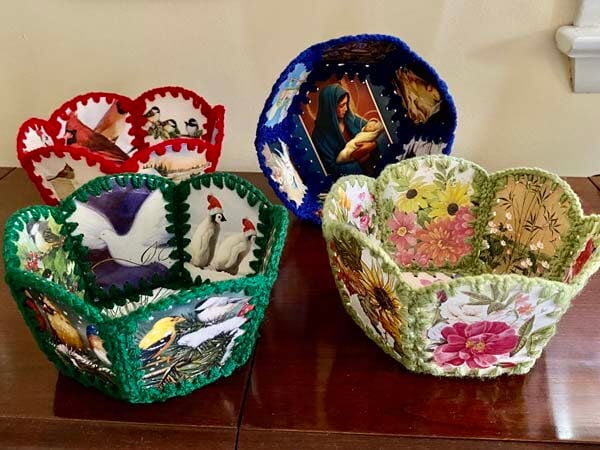‘Tis the season for updating one’s Christmas card list and mailing out greeting cards to friends and loved ones.
Wishing others holiday cheer and a happy new year in this manner is a longstanding tradition in many households.
According to Wikipedia, the first known Christmas card dates to 1611, when James I of England and his son, Henry Frederick, Prince of Wales, received a handmade Christmas greeting sent by Michael Maier.
Christmas cards did not become commercially available until a card commissioned by Sir Henry Cole in 1843. Sending greeting cards remained limited to the upper class of British society until 1873, when lithographer partners Prang and Mayer began creating Christmas cards for Britain’s popular market.
By 1874, those British cards were being sold in America, where Louis Prang earned the title “father of the American Christmas card.” Using the innovative process of chromolithography, Prang was able to produce more than 5 million cards per year during the 1880s.

Smiling snowmen lend a jaunty feel to this covered box with a globe-like shape.
It was World War I that made these greeting cards more popular than ever, as families sent them to loved ones in the military overseas.
During the post-World War II era, there evolved an interest in upcycling Christmas cards to make useful and decorative craft items.
Tracing patterns onto Christmas card illustrations, cutting them out and then connecting those pieces together with stitchery using thread or yarn gained a following among thrifty Americans.
Oftentimes, these objects were made by women who were part of church groups or charitable organizations for sale at their fundraisers.
Patricia Deichert of Lebanon County recalls cutting out the pattern shapes that had been traced onto old Christmas cards when she was a child in the early 1950s at Lebanon’s Assembly of God church.
Ladies of the church glued together the Christmas card sections and eventually linked them with crochet stitches to form items like pretty baskets for holding Christmas cards. These items were then sold at the church’s holiday bazaar.
Around 1960, Cleona Fire Co. No.1’s Ladies Auxiliary launched an annual holiday bazaar to help pay for Cleona Borough’s new firehouse. Among the many items handcrafted by auxiliary members were several styles of the craft made using old Christmas cards formed into decorative objects by crocheted stitching.

The lid on top of this small covered box opens.
Open baskets for Christmas cards, a rounded box with a lid, a bell-shaped tree ornament and a small house with a roof that opened were among the items created and sold.
Most items had a theme, using Christmas cards with similar images such as those made entirely of Santa Claus cards or snowmen cards.
The crochet thread for stitching these items together — typically red or green — was tastefully coordinated with the colors of the cards.
The exact pricing of Cleona Ladies Auxiliary’s handiwork has been lost to history. In spite of the time-consuming handiwork involved, these were inexpensive pieces that probably sold for anywhere from 50 cents to a dollar or two, depending on their size.
Some of them have become treasured keepsakes and, even though crafted from paper, have stood the test of time.
The popularity of sending Christmas cards, which had grown during the 20th century, began to wane around the 1990s. That’s when the advent of new technologies like email provided lower cost alternatives to send holiday wishes online.

A bell ornament features views of horses at work in the snow.
However, those same technologies have also brought good news.
Thanks to websites like Pinterest and Etsy, searching topics like “vintage crafts made from Christmas cards and crocheting” will not only yield numerous visual images of these retro crafts but also free patterns and instructions for modern crafters to achieve vintage-looking results.
The Pennsylvania-based website of Annette Rosanelli and her daughter Chris Rickert, needlepointers.com, is another good resource that offers step-by-step tutorials with photos and YouTube videos, as well as a monthly newsletter.
Click on their Trash to Treasure Crafts link to find “Recycle, Reuse, Repurpose and Upcycle Greeting Cards,” which includes their Christmas card basket instructions.
Rosanelli and Rickert come from a family with earlier generations of crocheters who passed along their skills and love for this art. Their history of crafting with needlework led them to launch their website over 20 years ago.
Rosanelli points out the Christmas card craft items don’t require advanced crocheting skills, since repeated single crochet stitches and some chain stitches are all that’s required. For non-crocheters, even a simple blanket stitch can work.

Featuring holiday greenery, this little house has a roof that opens on one side, making it the perfect spot for holding small treasures like pieces of candy.
Here’s one example of how to make a simple card craft:
To make a basket with four side panels, the pattern should be traced onto eight Christmas cards, since each piece will be glued back-to-back with another piece to form the inside and outside of the basket and add stability.
A pattern for the bottom of the basket will also be traced twice, with these pieces glued together. A small hole punch is then used to create a series of evenly spaced holes around each double-backed piece’s perimeter.
Next the side panels are laid out around the basket’s bottom piece and crochet stitching is used to attach the side pieces to the bottom.
Finally, the side panels are raised vertically and crocheted together to form the basket.
Crafters who save this year’s Christmas cards will have a head start on making next year’s vintage holiday ornaments and useful objects, either for themselves or as handcrafted gifts.










